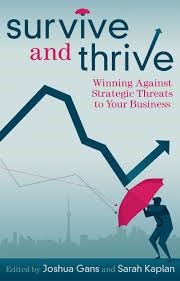- Governance
Winning Against Business Threats
Rotman professors on anticipating, responding to, and surviving strategic threats to your business - and thriving
According to Murphy's law: "Anything that can go wrong will go wrong."
Murphy’s adage is one every business leader needs to keep at the back of their mind. Self-inflicted threats such as IT meltdowns, employee discrimination law suits and budget overspend are common-place; as are external threats to reputation via social media and to market position from disruptive innovation. What’s more, sometimes disasters happen that can threaten the very survival of the business.
The key is to anticipate potential threats and to be ready with effective responses. That is the premise of Survive and Thrive: Winning Against Strategic Threats to Your Business, a new book featuring a collection of essays from strategy professors at the University of Toronto’s Rotman School of Management, edited by professors Joshua Gans and Sarah Kaplan.

The book opens with a reminder of the recent nightmare at the 2017 Academy Awards when, charged with managing the winners’ envelopes, PWC contrived to let the best picture Oscar go mistakenly to ‘La-la Land’ rather than the real winner ‘Moonlight’. Although a short-term crisis rather than an existential threat, this illustrates how even the most sophisticated of organizations, handling seemingly boring routine work, can get things badly wrong.
Using numerous real examples, from BP to Walmart, the essays consider a range of threats faced by organizations today, from disruptive innovation, to social media disasters, to mistaken technical investments, to gender discrimination, to misunderstood competition. The authors trace how and why these treats materialized and look at what managerial strategies, successful and otherwise, were put in place to counter them.
The examples studied reveal four mistakes that organizations commonly make:
Failing to appreciate interactions within systems ― Not looking past the superficial to consider potential unintended consequences.
Getting stuck in existing ways of doing business ― Doubling down on existing practices rather than looking for new solutions and models to confront crises.
Falling victim to cognitive biases ― Leaders need to face threats with open minds unencumbered by past biases.
Getting derailed by short-term incentives ― Economic pressures, often driven by customer demands, can blind business to associated risk.
However, the main focus of the book is not on mistakes but on the actions organizations can take, first to anticipate and avoid threats, and secondly to deal with treats head on to minimise the damage and in some case to ensure the company stays afloat. With its emphasis on “anticipate what you can; prepare for what you can’t,” the book offers a series of principles and practices aimed at ensuring businesses not only survive but thrive.
In the first instance it points to two essential actions needed to avoid organizational mistakes (both come with caveats):
Develop structured practices for anticipation. This involves risk reviews, post-mortems, anomaly reporting systems, etc., which can be important in picking up vital information signals. Caveat: Beware of ‘risk compensation’ – the tendency to take even greater risks once safety measures are in place.
Create an organizational culture that encourages dissent. A supportive culture will encourage diversity of thought and pay heed to ideas and criticisms that differ from the existing ways of doing business. Caveat: Don’t take the easy way out. To truly pay heed it may be necessary to leap-frog current practices and make radical organizational changes.
The fear of potential threats, coming as they do from so many directions, can appear overwhelming. Although essentially reassuring, this book does not minimize these understandable fears but offers practical approaches to analysing threats, investigating solutions and delivering effective responses to the threats every senior business leader faces.
About the editors:
Joshua S. Gans is a professor of Strategic Management and holds the Jeffrey S. Skoll Chair of Technical Innovation and Entrepreneurship at the Rotman School of Management. He is also chief economist of the University of Toronto’s Creative Destruction Lab.
Sarah Kaplan, Director of the Institute for Gender and the Economy at the Rotman School of Management, is also Distinguished Professor of Gender and the Economy and a professor of Strategic Management at Rotman.
Survive and Thrive: Winning Against Strategic Threats to Your Business, published by Dog Ear Publishing, 2017, ISBN 978-4575-5665-4
Rotman School of Management is Canada’s leading business school and has Canada’s largest group of management faculty. It is home to some of the most innovative research institutes in the world
ARTICLES YOU MIGHT LIKE
VIDEO
WEBINAR RECORDING: Prof. Walid Hejazi, Andrea Barrack, and Susan McGeachie explore and debunk some of the enduring myths surrounding ESG
DEVELOPING LEADERS QUARTERLY MAGAZINE AND WEEKLY BRIEFING EMAILS


































